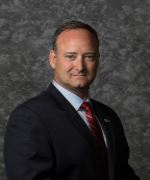
Brigham McCown
Degrees and Institutions
- J.D., Law, Northern Kentucky University
- M.B.A., Business Administration, College of William and Mary
- G.Cert., Energy Innovation and Emerging Technologies, Stanford University
- B.A., Diplomacy & Foreign Affairs, Miami University
Work in Progress
Professor McCown’s teaching and research focus on areas pertaining to the intersection of law, policy, and politics. He is often quoted by the international and national; press corps in matters pertaining to energy, the environment, regulations, law, and national security. Professor McCown has taught in multiple colleges at Miami University and is currently working on a regulatory law and public policy textbook. Mr. McCown has more than three decades of domestic and foreign policy experience while serving in key positions within industry, government, and the military.He has formerly worked in three presidential administrations, and presidential transition teams, served on federal boards, and is also a retired naval aviator and entrepreneur. Professor McCown was slated the hold the position of Associate Deputy Attorney General for National Security at the U.S. Department of Justice in 2018 but went on to become the President of the world’s most iconic energy transportation system, the Trans-Alaska Pipeline.
Select Publications
Recent Blog Posts, Essays, & Op-eds
- March 2023.How Low Can You Go?Real Clear Energy.
- January 2023.Counter Extreme Weather with Sound Energy PolicyThe Hill.
- January 2023. America Can Do More for Its Allies—and Itself The Wall Street Journal.
- December 2022. America Can Do More for Its Allies—and Itself The Wall Street Journal.
- November 2017. Grid Security: Between Hype and Heads in the Sand. Schar School of Policy and Government, George Mason University.
Selected Articles
- (2018). “The Hidden Price of Outdated Damage Prevention Laws.” Construction Executive. Part I and Part II.
- (2017). "The Fine Line Between Protecting Your Rights and Obstructing an Investigation."The Transportation Lawyer, Volume 17, Number 5.
- (2015). "The Role of Improved Communication & Technology in Enhancing Damage Prevention Practices: Why use 20th Century Technology to Combat 21st Century Safety Challenges?”The International Confederation of Energy Regulators (ICER) Chronicle, Edition 4.
- (2015). “Is Europe Truly Unified”,European Energy Review.
- (2013). “Protecting U.S. Pipelines from Cyber-Attack."Critical Infrastructure Report, Volume 11, Number 12, George Mason University School of Law, Center for Infrastructure and Homeland Security.
- (2008). "Safeguarding the Energy Pipeline Transportation System & the Pipes Act of 2006"Texas Journal of Oil, Gas, and Energy Law, Volume 3, Number 1, University of Texas School of Law.
- (2007). “Federal Hazardous Materials Regulations, Who's in Charge?"The National Transportation Safety Board Bar Association.
- (2007). “PIPES Act Impacts on Energy Providers.”Energy Law 360
- (2007). “PIPES Act Presents Far-Reaching Changes for Energy Providers."Houston Business Journal.
Participating Legal Cases
- (2005).Mid-Con Freight Systems, Inc. et al. v. Michigan Public Service, et al., 125 S.Ct. 242, 162 L.Ed.2d 418. Amicus Curiae brief by the United States Department of Transportation on whether state fee statute was preempted by federal statute as to entities engaged in interstate commerce.
- (2004). U.S. Department of Transportation v. Public Citizen, 124 S.Ct. 2204, 159 L.Ed.2d 60. Reversal of circuit court decision invalidating agency rules for entry of Mexico domiciled commercial trucks and buses for non-compliance with the National Environmental Policy Act of 1969 (NEPA), and the Clean Air Act (CAA).
- (2005).Commodity Carriers, Inc. v. FMCSA, 434 F.3d 604. Petition for review and stay of final agency order regarding commercial company safety rating and application of regulations associated with maintenance of company documents.
- (2005)Advocates for Highway and Auto Safety v. FMCSA, 429 F.3d 1136. Advocacy organizations petitioned for judicial review of final rule of United States Department of Transportation (DOT) implementing entry-level training requirements for drivers of commercial motor vehicles pursuant to the Intermodal Surface Transportation Efficiency Act of 1991 (ISTEA).
- (2005) “A Court of Laws or a Super Legislature: A Neo-Institutional Model of Supreme Court Decision Making” with Richard Pacelle. In Eds: Mark C. Miller,Rethinking U.S. Judicial Politics, Oxford University Press.
- (2005)Pope v. United States DOT, 421 F.3d 480. Appeal of District Court matter of employment law and hiring practices.
Legislative and Executive Branch Testimony
- (2023). Application of Carbon Dioxide Pipeline for carbon Reduction. Before the Public Services Commission of North Dakota.
- (2019). USDOT PHMSA Safety Reauthorization. Before the Subcommittee on Energy and Commerce, U.S. House of Representatives, Washington, DC.
- (2019). Texas Energy Infrastructure Safety Bills. Before the Before the Texas House of Representatives Energy Resources Committee, Austin, TX.
- (2014). Rover Natural Gas Pipeline Project. Before the Federal Energy Regulatory Commission, Flint, MI.
- (2013). Keystone XL Pipeline Project on the Draft Environmental Impact Statement. Before the United States Department of State, Grand Island, NE.
- (2013). Keystone XL Pipeline: Examination of Scientific & Environmental Issues. Before the Subcommittee on Energy and the Subcommittee on Environment; Committee on Science, Space and Technology, U.S. House of Representatives, Washington, DC.
- (2012). Nebraska Keystone Pipeline Evaluation. Before the Nebraska Department of Environmental Quality, Albion, NE.
- (2011). Nebraska Special Session on Energy Transportation. Before the Committee on Natural Resources, Lincoln, NE.
- (2006). Progress in Enhancing Pipeline Safety. Before the Subcommittee on Highways, Transit and Pipelines; Committee on Transportation and Infrastructure, U.S. House of Representatives, Washington, DC.